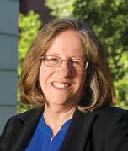Suzanne Weaver Smith, PhD
was enshrined in 2019
was enshrined in 2019

In 1980, Suzanne Weaver Smith’s career ambitions were academia; however, she knew aerospace R&D experience would enable her to better educate students planning careers in industry or in research. So she went to work for Harris Corporation’s Government Aerospace Systems Division. Her first assignment? Developing test-validated computer models for vibration of the fine guidance electronics of the Hubble Space Telescope to assess its launch survivability. From this work, themes in Smith’s research career emerged: unique test-validated analysis of dynamics for historic projects in collaboration with aerospace industry leaders.
Validated analysis of the cross-country performance of the mobile ground communications station of the first U.S. unmanned aircraft followed before Smith returned for her doctorate in engineering mechanics from Virginia Tech. Her Ph.D. research was funded by NASA to determine the feasibility of using vibration measurements to locate damage in the backbone structure of the newly-announced International Space Station (ISS). Smith joined the faculty of the University of Kentucky College of Engineering in 1990 where she has held the Donald and Gertrude Lester Professorship in Mechanical Engineering since 2004.
In 1992, Smith received the prestigious National Science Foundation (NSF) Young Investigator Award—to partner with industry and research nonlinear vibration interactions in large flexible structures like the solar arrays on the ISS. Smith partnered with Boeing, which was building the ISS at the time. She and her students also joined the team led by Boeing that conducted on-orbit vibration tests of the Russian Mir Space Station. Smith started the new century continuing her research with unique flexible structures and testing in extreme or unusual environments, working with both large and small companies. One project modeled the deployment of inflatable-boom spacecraft validated with microgravity experiments conducted by students—the Weightless Wildcats. From this and her early experience with unmanned aircraft systems (UAS), Smith and a multidisciplinary team of faculty researchers began working on what would become the five-year BIG BLUE Mars Airplane program—to demonstrate the feasibility of inflatable wings for aircraft to explore Mars—while providing an amazing multi-disciplinary career-changing experience for over 300 engineering students. With ILC Dover, the team designed four different wings and deployment experiments, successfully conducting them at altitudes between 60,000 and 95,000 ft. These were cited for increasing the Technology Readiness Level (TRL) of inflatable wings for planetary exploration. The achievement led to industrial collaborations from 2009-2012 that advanced deployable-wing technologies for the Defense Advanced Research Projects Agency (DARPA) and other sponsors.
In 2010, Smith was selected to lead NASA’s investments in workforce and seed research under the NASA Kentucky Space Grant and ESPCoR programs. These programs provide amazing experiences for students, along with key start-up support for early-career faculty across Kentucky. Today, using unmanned aircraft and rotorcraft, Smith and researcher’s campus-wide collaborate on applications from bridge inspections to precision agriculture, working with industry via UK’s Unmanned Systems Research Consortium, which launched in December 2013 and currently has five industry members.
Recently, Smith and a three-state multi-disciplinary team received a $6 million NSF grant to use unmanned aircraft to answer key scientific questions in atmospheric physics impacting severe weather formation and sustainable agriculture.
Validated analysis of the cross-country performance of the mobile ground communications station of the first U.S. unmanned aircraft followed before Smith returned for her doctorate in engineering mechanics from Virginia Tech. Her Ph.D. research was funded by NASA to determine the feasibility of using vibration measurements to locate damage in the backbone structure of the newly-announced International Space Station (ISS). Smith joined the faculty of the University of Kentucky College of Engineering in 1990 where she has held the Donald and Gertrude Lester Professorship in Mechanical Engineering since 2004.
In 1992, Smith received the prestigious National Science Foundation (NSF) Young Investigator Award—to partner with industry and research nonlinear vibration interactions in large flexible structures like the solar arrays on the ISS. Smith partnered with Boeing, which was building the ISS at the time. She and her students also joined the team led by Boeing that conducted on-orbit vibration tests of the Russian Mir Space Station. Smith started the new century continuing her research with unique flexible structures and testing in extreme or unusual environments, working with both large and small companies. One project modeled the deployment of inflatable-boom spacecraft validated with microgravity experiments conducted by students—the Weightless Wildcats. From this and her early experience with unmanned aircraft systems (UAS), Smith and a multidisciplinary team of faculty researchers began working on what would become the five-year BIG BLUE Mars Airplane program—to demonstrate the feasibility of inflatable wings for aircraft to explore Mars—while providing an amazing multi-disciplinary career-changing experience for over 300 engineering students. With ILC Dover, the team designed four different wings and deployment experiments, successfully conducting them at altitudes between 60,000 and 95,000 ft. These were cited for increasing the Technology Readiness Level (TRL) of inflatable wings for planetary exploration. The achievement led to industrial collaborations from 2009-2012 that advanced deployable-wing technologies for the Defense Advanced Research Projects Agency (DARPA) and other sponsors.
In 2010, Smith was selected to lead NASA’s investments in workforce and seed research under the NASA Kentucky Space Grant and ESPCoR programs. These programs provide amazing experiences for students, along with key start-up support for early-career faculty across Kentucky. Today, using unmanned aircraft and rotorcraft, Smith and researcher’s campus-wide collaborate on applications from bridge inspections to precision agriculture, working with industry via UK’s Unmanned Systems Research Consortium, which launched in December 2013 and currently has five industry members.
Recently, Smith and a three-state multi-disciplinary team received a $6 million NSF grant to use unmanned aircraft to answer key scientific questions in atmospheric physics impacting severe weather formation and sustainable agriculture.
